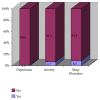Burnout Syndrome among Emergency Physicians and Nurses in Abha and Khamis Mushait Cities, Aseer Region, Southwestern Saudi Arabia
- PMID: 30906233
- PMCID: PMC6398028
- DOI: 10.1155/2019/4515972
Burnout Syndrome among Emergency Physicians and Nurses in Abha and Khamis Mushait Cities, Aseer Region, Southwestern Saudi Arabia
Abstract
Objectives: To explore the magnitude and determinants of burnout among emergency physicians and nurses working at emergency departments of hospitals in Abha and Khamis Mushait cities.
Subjects and methods: A cross-sectional hospital-based study was conducted in emergency departments of hospitals in Abha and Khamis Mushait cities belonging to Ministry of Health. All physicians (n=95) and nurses (n=187) currently working at these sites were invited to participate in the study by filling a validated self-administered questionnaire including two main sections: personal and professional characteristics of physicians and nurses as well as Maslach burnout inventory (MBI) to assess the three components of the burnout syndrome: emotional exhaustion, depersonalization, and reduced personal accomplishment.
Results: The study included 282 physicians and nurses. The age of more than half of them (54.3%) ranged between 31 and 35 years. Most of them (70.9%) were females. About two-thirds of the respondents (66.3%) were nurses while the remaining 33.7% were physicians. Majority of the emergency healthcare professionals (88.7%) had high emotional exhaustion. The prevalence of high depersonalization (cynicism) was 20.6% whereas that of low personal accomplishment was 41.1% among emergency healthcare professionals. The overall prevalence of burnout among healthcare professionals was 16.3%. Multivariate logistic regression analysis revealed that male healthcare professionals were at almost higher three-folded risk for developing burnout compared to females (aOR=2.76; 95% confidence interval (CI): 1.21-6.28, p=0.017)). Smokers were at higher significant risk for burnout compared to nonsmokers (aOR=15.37; 95% CI: 7.06-33.45, p<0.001). Healthcare professionals who reported a history of taking medications for sleep disorders expressed higher risk for burnout opposed to those with no history of sleep disorder medication (aOR=6.59; 95% CI: 2.08-20.81, p=0.001).
Conclusion: A considerable proportion of physicians and nurses working at emergency departments of hospitals in Abha and Khamis Mushait cities had burnout syndrome, particularly high emotional exhaustion and low personal accomplishment.
Figures






References
-
- Bragard I., Dupuis G., Fleet R. Quality of work life, burnout, and stress in emergency department physicians. European Journal of Emergency Medicine. 2015;22:227–234. - PubMed
-
- Maslach C., Jackson S. E., Leiter M. P. Maslach Burnout Inventory Manual, Mind garden.com. 3rd. California, Calif, USA: Consulting Psychologists Press, Inc.; 1996.
MeSH terms
LinkOut - more resources
Full Text Sources
Medical

